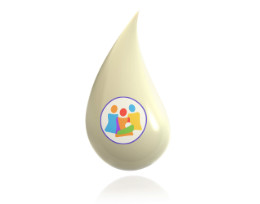Tandem Feeding
Tandem feeding most often means breastfeeding a newborn and an older child. This often comes about naturally when a breastfeeding parent becomes pregnant, and continues to breastfeed during pregnancy. The parent will breastfeed both the newborn and the older child.
Tandem Feeding Early Postpartum
After delivery, colostrum changes to transitional milk around days 3-5 postpartum (the time when the milk “comes in”). Before the milk comes in, it is especially important for the newborn to feed frequently to ensure they are receiving adequate calories and fluid. The breastfeeding parent may decide to only feed their newborn during those first few days. If the older child also continues to breastfeed during those early days, make sure the new baby has priority for feeding on demand and allow the older child to feed right after the newborn feeds. Once the milk “comes in”, many people find they are able to produce enough milk for both their older child and their baby.
Benefits of Tandem Feeding
Tandem nursing can provide benefits for the entire family. Breastfeeding can help the older child adapt to the changes in family dynamics with a new baby by providing security and special moments of attention. The older child can also help support and boost milk production if the infant is having difficulties breastfeeding. Older children who continue breastfeeding stay healthier and are less likely to transmit illnesses to the newborn and other family members.
Risks of Tandem Feeding
If a breastfeeding parent has had any issues with milk production in the past, tandem feeding may result in the exclusively breastfed infant not receiving enough breastmilk. A good strategy is to allow the exclusively breastfed infant to nurse first before the older child. The parent and infant should also be closely followed by lactation support.
Positioning During Tandem Feeding
If the breastfeeding parent is feeding an infant and older child at the same time, some people find it is easiest to comfortably position and latch the infant before allowing the toddler to latch. This helps to ensure that the infant is latched on well before being distracted by the toddler’s behavior. Also it is recommended to position oneself so that the infant can be observed during feeding.
Tips for Tandem Feeding
- Breastfeed the infant on demand, to ensure sufficient breastmilk intake.
- Consider boundaries, if needed, for the older child:
- How often they can feed
- What time of day is best for them to feed
- Whether to feed the older child at the same time as the infant or after
- Feed the infant before the older child if there are any concerns about milk production.
- Everyone’s tandem feeding journey is different! Consider seeing a lactation specialist for guidance on questions or concerns


